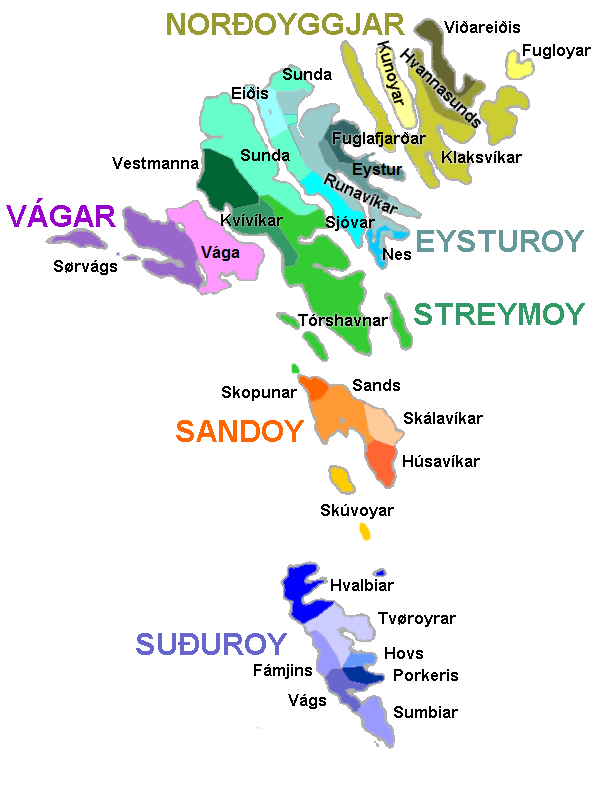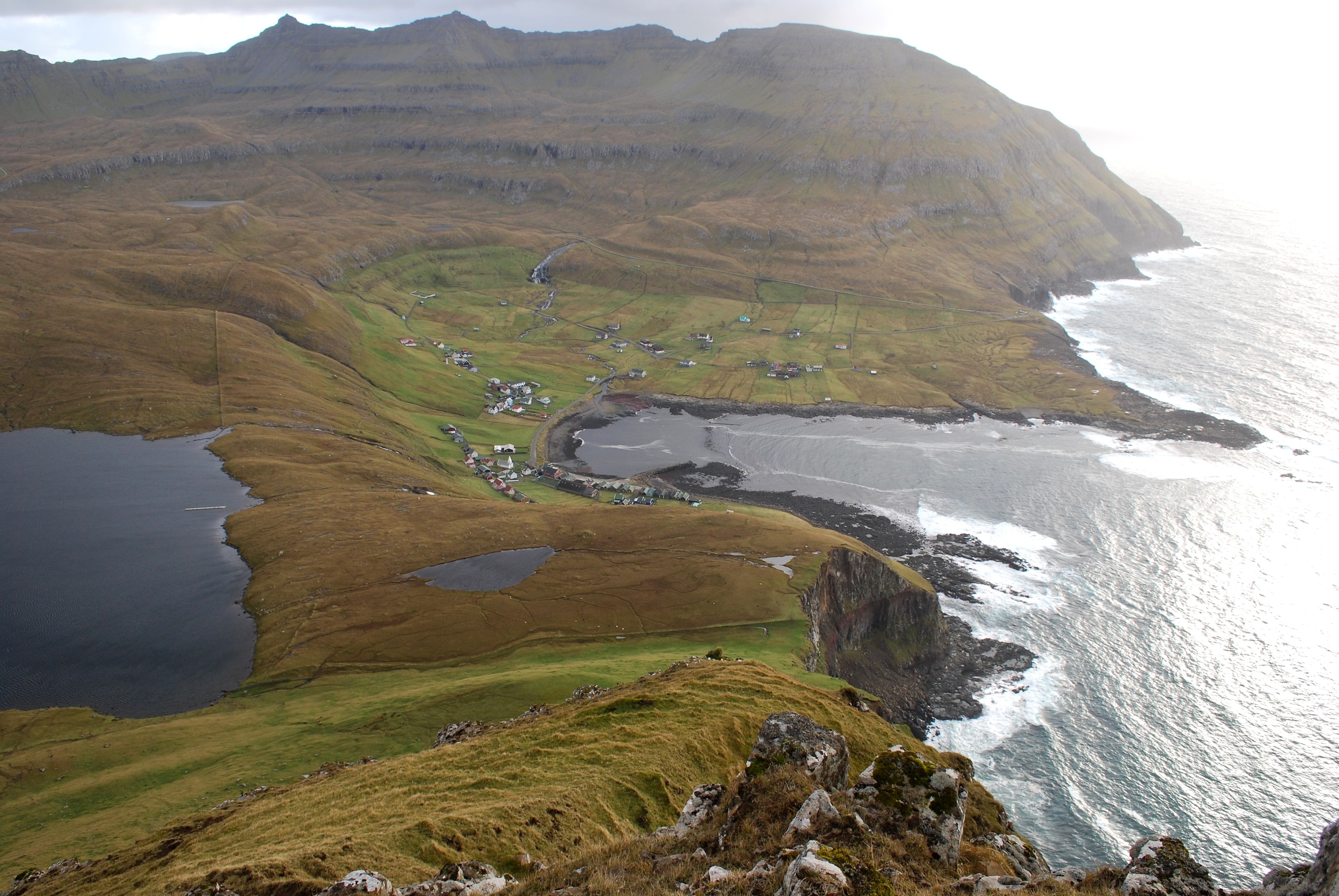|
Sumba, Faroe Islands
Sumba is the southernmost village of the Faroe Islands, located on the island of Suðuroy. It is located in Sumbiar Municipality. Municipality The municipality has 354 inhabitants (as of April 2022). 252 of these people live in Sumba. The other villages in the Municipality of Sumba are: Lopra (89 inhabitants), Akrar (14 inhabitants), and formerly Víkarbyrgi (0 inhabitants). Sumba is known for several things, including the high bird cliff of Beinisvørð and the local practice of Faroese chain dancing. They are very good dancers and have a long tradition for singing long songs along with the chain dance. Poul F. Joensen (born 1898 - died 1970) is one of the most famous Faroese poets; he was born in Sumba and grew up there. Later he got married and moved to Froðba. Residents of the village are known as ''Sumbingar''. The name Sumba or Sunnba is from the old name of the village which was Sunnbø/ba or Sunnbøur which means the southernmost village, but over the years misspell ... [...More Info...] [...Related Items...] OR: [Wikipedia] [Google] [Baidu] |
Suðuroy
Suðuroy (literally South Island, da, Suderø) is the southernmost of the Faroe Islands. The island covers 163.7 square kilometres (63.2 sq mi). In 2018 the population was 4,601. Suðuroy region (sýsla) comprises this island and Lítla Dímun, the next isle northward in the Faroes, which is uninhabited. History One ancient settlement, Víkarbyrgi was abandoned late in the 1990s. Another settlement, Akraberg was abandoned around 1350 because of the Black Death; the people who lived there at that time came from Friesland, and legend has it that people in Hørg (in Sumba) can trace their ancestry back to this settlement, which was situated on the southernmost point of the island. In the 17th century, Suðuroy was subjected to repeated attacks by North African pirates, who in the Faroe Islands were referred to as Turks when North Africa belonged to the Ottoman Empire. One well known such incident was the Slave raid of Suðuroy .They abducted several women and child ... [...More Info...] [...Related Items...] OR: [Wikipedia] [Google] [Baidu] |
Froðba
Froðba ( da, Frodebø) is a village located farthest out on the north brink of Trongisvágsfjørður, an inlet on the east coast of the island of Suðuroy in the Faroe Islands. History The village has eventually merged with the harbour-city of Tvøroyri. Froðba is usually divided into smaller places such as Hamri, Undir Skorum, Støðlunum, Torvheyggur and Bøur. Bøur is usually referred to as "Úti á Bø" the oldest inhabited area in Froðba, Bøur has a small graveyard which used to be the only one in Trongisvágsfjørður. It is no longer in use and Froðba used to have a church which was in Bø but after Froðba merged with the growing nearby town of Tvøroyri, the small church was moved to Tvøroyri, and later as the population grew the church was replaced and moved to Sandvík. Tradition says that Froðba is the oldest village on Suðuroy and in the Faroe Islands. A legendary Danish king, Frode or Fróði, ran ashore and settled here. The place is named after him. The ... [...More Info...] [...Related Items...] OR: [Wikipedia] [Google] [Baidu] |
Populated Places In The Faroe Islands
Population typically refers to the number of people in a single area, whether it be a city or town, region, country, continent, or the world. Governments typically quantify the size of the resident population within their jurisdiction using a census, a process of collecting, analysing, compiling, and publishing data regarding a population. Perspectives of various disciplines Social sciences In sociology and population geography, population refers to a group of human beings with some predefined criterion in common, such as location, race, ethnicity, nationality, or religion. Demography is a social science which entails the statistical study of populations. Ecology In ecology, a population is a group of organisms of the same species who inhabit the same particular geographical area and are capable of interbreeding. The area of a sexual population is the area where inter-breeding is possible between any pair within the area and more probable than cross-breeding with in ... [...More Info...] [...Related Items...] OR: [Wikipedia] [Google] [Baidu] |
Municipalities Of The Faroe Islands
The Faroe Islands are administratively divided in 29 municipalities (''kommunur''), with about 120 cities and villages. Until December 31, 2008, there were 34 municipalities, and until December 31, 2004, there were 48 municipalities. In the coming years the number of Faroese municipalities is expected to drop to somewhere between 7 and 15, as there is currently a rationale towards municipal amalgamation and a decentralization of public services. In 1998 it was suggested that no municipality should have fewer than 2,000 inhabitants, but whether this will be true is a political question. The Faroese government has furthermore decided not to conduct forced, top-down amalgamation, but to leave the process to the free will of the municipalities. In many small municipalities there is some resistance to the amalgamation process, and as a result two kinds of municipalities are being created: large municipalities (town-municipalities) that are eager to attract smaller municipalities into ama ... [...More Info...] [...Related Items...] OR: [Wikipedia] [Google] [Baidu] |
List Of Towns In The Faroe Islands ...
This is a list of villages (and towns) of the Faroe Islands. :fo:Býir í Føroyum :de:Liste der Städte und Orte auf den Färöern References {{DEFAULTSORT:List Of Towns In The Faroe Islands Towns Faroe Islands The Faroe Islands ( ), or simply the Faroes ( fo, Føroyar ; da, Færøerne ), are a North Atlantic archipelago, island group and an autonomous territory of the Danish Realm, Kingdom of Denmark. They are located north-northwest of Scotlan ... [...More Info...] [...Related Items...] OR: [Wikipedia] [Google] [Baidu] |
Photovoltaic Power Station
A photovoltaic power station, also known as a solar park, solar farm, or solar power plant, is a large-scale grid-connected photovoltaic power system (PV system) designed for the supply of merchant power. They are different from most building-mounted and other decentralised solar power because they supply power at the utility level, rather than to a local user or users. The generic expression utility-scale solar is sometimes used to describe this type of project. The solar power source is solar panels that convert light directly to electricity. However, this differs from and should not be confused with concentrated solar power, the other major large-scale solar generation technology, which uses heat to drive a variety of conventional generator systems. Both approaches have their own advantages and disadvantages, but to date, for a variety of reasons, photovoltaic technology has seen much wider use. , about 97% of utility-scale solar power capacity was PV. In some countries, ... [...More Info...] [...Related Items...] OR: [Wikipedia] [Google] [Baidu] |
FC Suðuroy
FC Suðuroy is a Faroese football club which was founded in January 2010 and consists currently of the former clubs VB (founded in 1905) and Sumba (founded in 1949), which merged in 2005 to form VB/Sumba. FC Suðuroy's first team in the men's championship competes in the 1. deild in 2021. All teams play their home games at the á Eiðinum Stadium in Vágur. The club logo was designed by the photographer Rógvi Nolsøe Johansen in 2010, the same year he won the competition to design a logo for the club. History VB/Sumba played in 1. deild (1. division, which is the second tier) in 2009 and won the division. FC Suðuroy therefore played their first season in the Faroe Islands Premier League, which was called Vodafonedeildin from 2009 to 2011. FC Suðuroy played their first league match on 1 April 2010 against the champions HB Tórshavn. The result was 4–4. FC Suðuroy didn't make it in Vodafonedeildin, they were relegated and played in 1. deild in 2011. They won the divisio ... [...More Info...] [...Related Items...] OR: [Wikipedia] [Google] [Baidu] |
Tvøroyri
Tvøroyri is a village on the north side of the Trongisvágsfjørður on the east coast of Suðuroy island in the Faroe Islands. Together with Froðba, Trongisvágur, Líðin and Øravík it forms Tvøroyri Municipality. The village is considered to have been founded in 1836, when the Royal Danish Monopoly Trade Store was founded on a small tongue of land, called Tvøroyri. In a short span of years, Tvøroyri grew into a large village, mainly after 1856 when the monopoly state of the store was abolished. Around the turn of the 20th century, Tvøroyri was one of the largest towns on the Faroe Islands and had one of the main fishing industries. Overview The church in Tvøroyri was constructed in Norway as a building set, moved to Tvøroyri and then built here in 1907, ready to use in 1908. The old church was moved to Sandvík. Trongisvágur Trongisvágur is the village furthest to the west of the inlet of Trongisvágsfjørður. Trongisvágur is where most of the new residentia ... [...More Info...] [...Related Items...] OR: [Wikipedia] [Google] [Baidu] |
Vágur
Vágur meaning ''Bay'' ( da, Våg) is a town on the island of Suðuroy, part of the Faroe Islands It is situated on the east coast of the island on the Vágsfjørður fjord, and was founded in the fourteenth century. Expansion has meant that the nearby town of Nes is now a suburb of Vágur. Vágur has a sports hall next to the football grounds on Eiðinum, near Vágseiði, a swimming pool by the school and a clinic which offers the services of doctors, nurses and dentists. There is also a hotel, one bank and various shops. The port area, which is 14 m in depth, is situated on the northern part of the fjord. The port authorities can offer services of piloting (lods), water and fire-fighting, and in connection with the harbour there is a modern fish factory and auctioneers for fish. Salmon farming is also a part of the fish industry in Vágur, this includes salmon farm rings on the fjord and in other places near the east coast of Suðuroy and a salmon factory. The town has a slip ... [...More Info...] [...Related Items...] OR: [Wikipedia] [Google] [Baidu] |
Sumbiarhólmur
Sumbiarhólmur is an islet in the Faroe Islands, located just outside the village of Sumba, which is the southernmost village on the island of Suðuroy Suðuroy (literally South Island, da, Suderø) is the southernmost of the Faroe Islands. The island covers 163.7 square kilometres (63.2 sq mi). In 2018 the population was 4,601. Suðuroy region (sýsla) comprises this island and Lítla .... At 7 hectares in area, Sumbiarhólmur is the 6th largest islet of the Faroe Islands. The North Atlantic Ocean is often quite rough near Sumbiarhólmur and around Flesjarnar further south. Boat accidents have happened in the area. (''in Faroese'') People from Sumba graze rams on the islet in summertime. References External links [...More Info...] [...Related Items...] OR: [Wikipedia] [Google] [Baidu] |
Fámjin
Fámjin ( da, Famien) is a village located on the western side of Suðuroy, the southernmost island in Faroe Islands. Fámjin is looking directly out to the North Atlantic Ocean. Name Geography The village of Fámjin faces the ocean, although partly protected by a stone reef, which becomes visible at low tide. The village is surrounded by some of the highest mountains on Suðuroy. The highest mountain, Gluggarnir is located north of Fámjin. The mountains Borgarknappur and Borgin are south-east of the village. There are several inland lakes and waterfalls. One of the waterfalls is named Fossurin Mikli. Only one road leads to the village, it goes through Øravík. North of the village lies the “ Kirkjuvatn” (Church Lake), one of the largest on the island. The old mountain path between Fámjin and Vágur was originally the main road between the two villages. There are cairns along the path. West of Fámjin by the end of the road is a gorge which is called Prestgjógv (Th ... [...More Info...] [...Related Items...] OR: [Wikipedia] [Google] [Baidu] |




.jpg)


